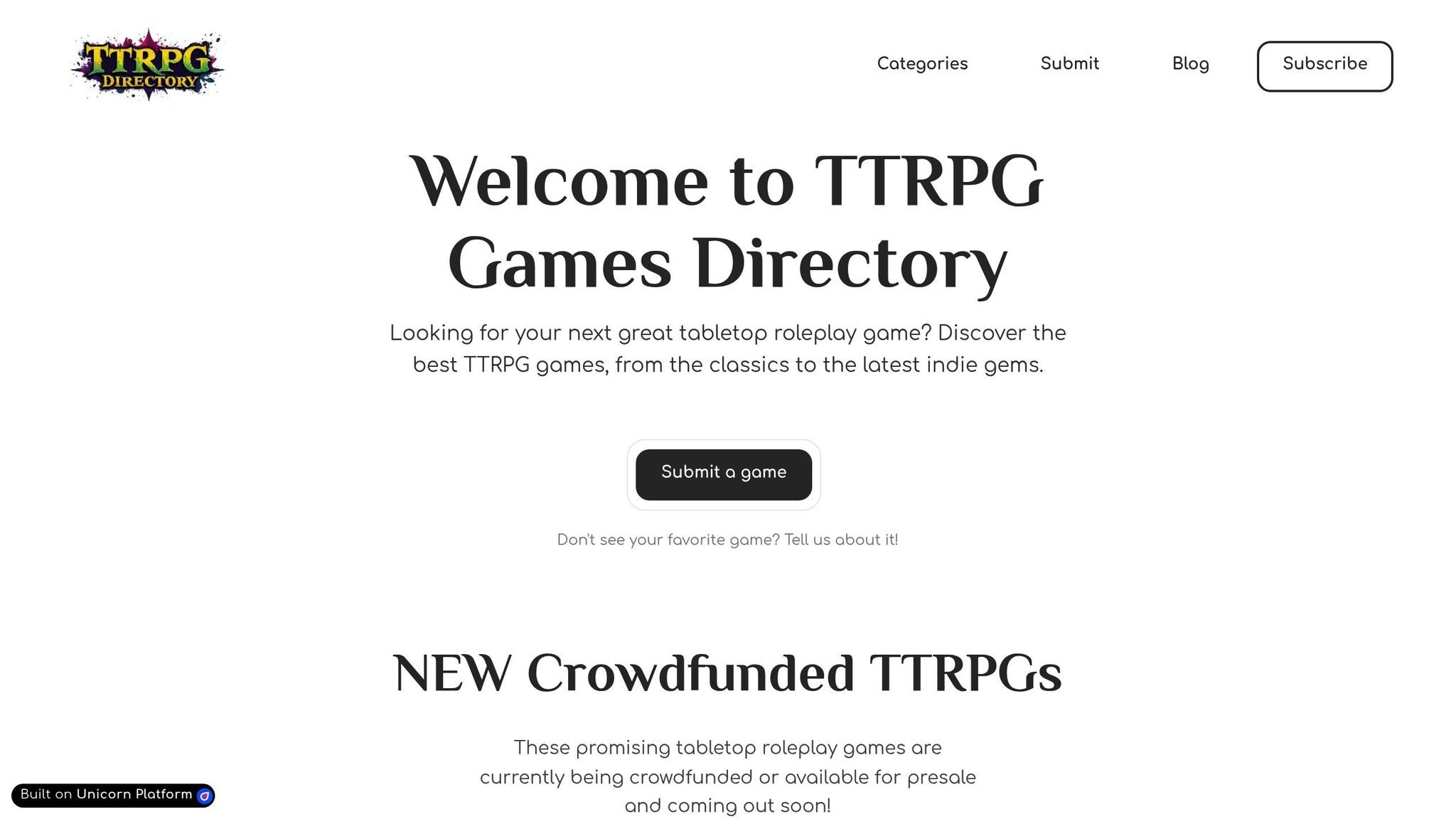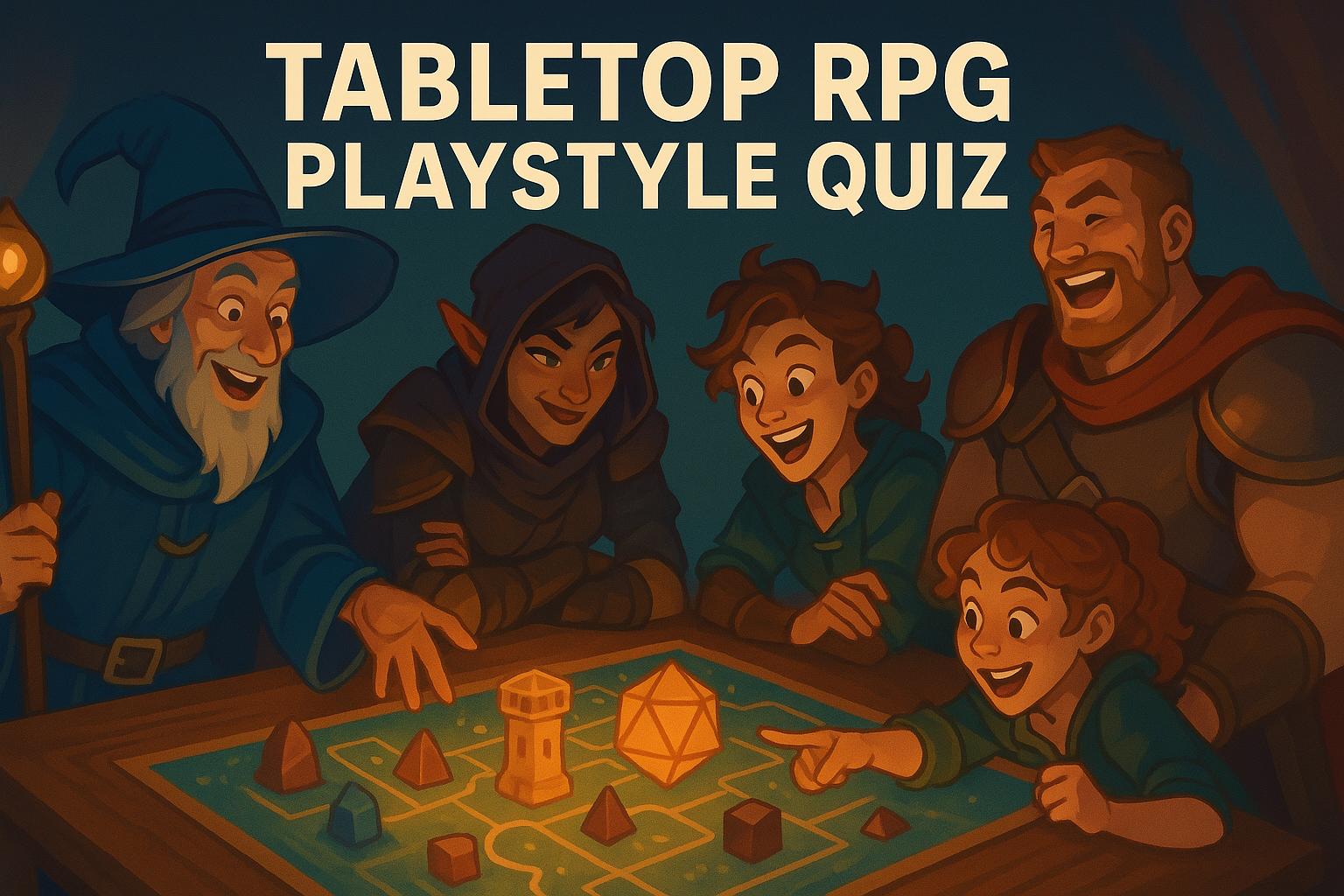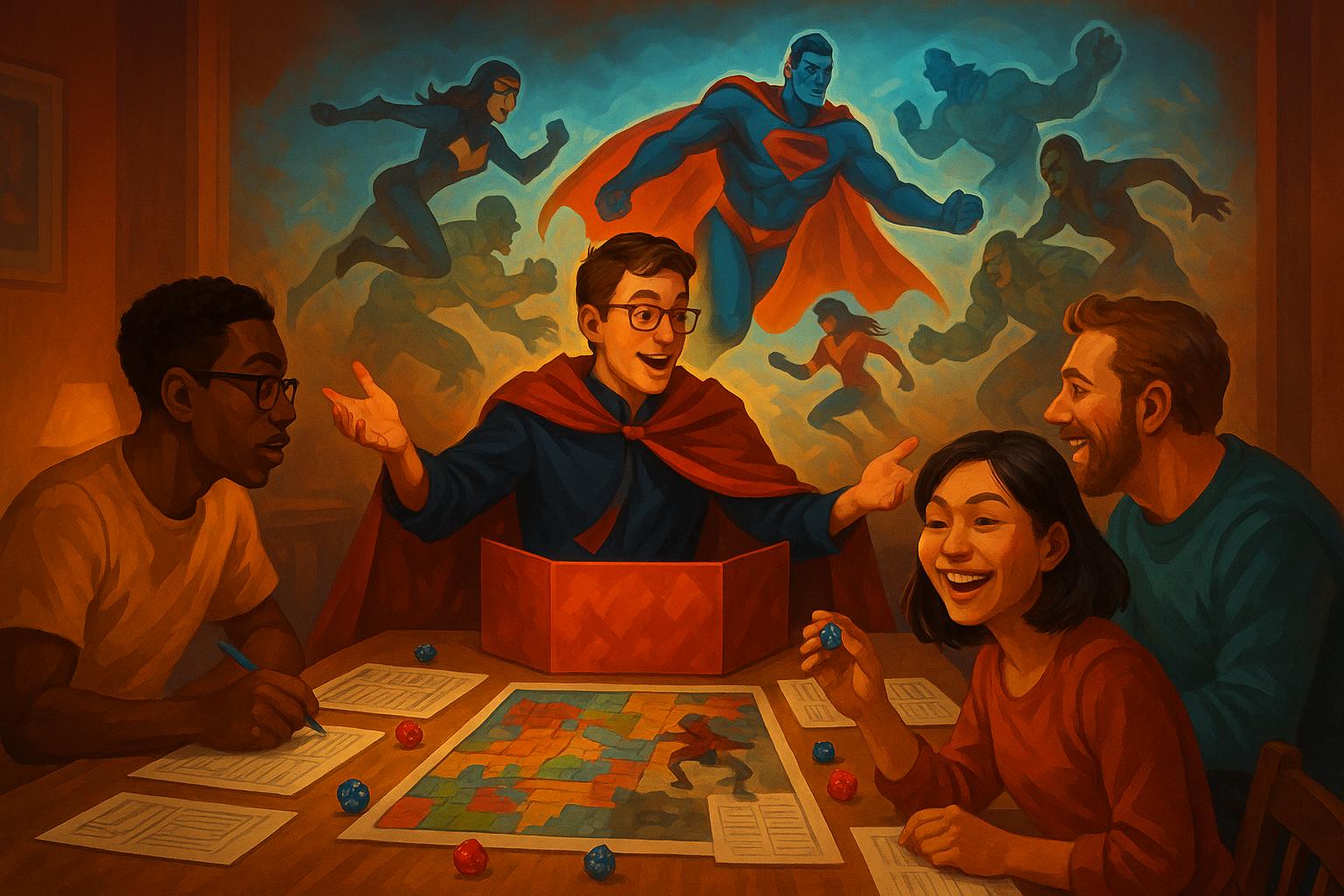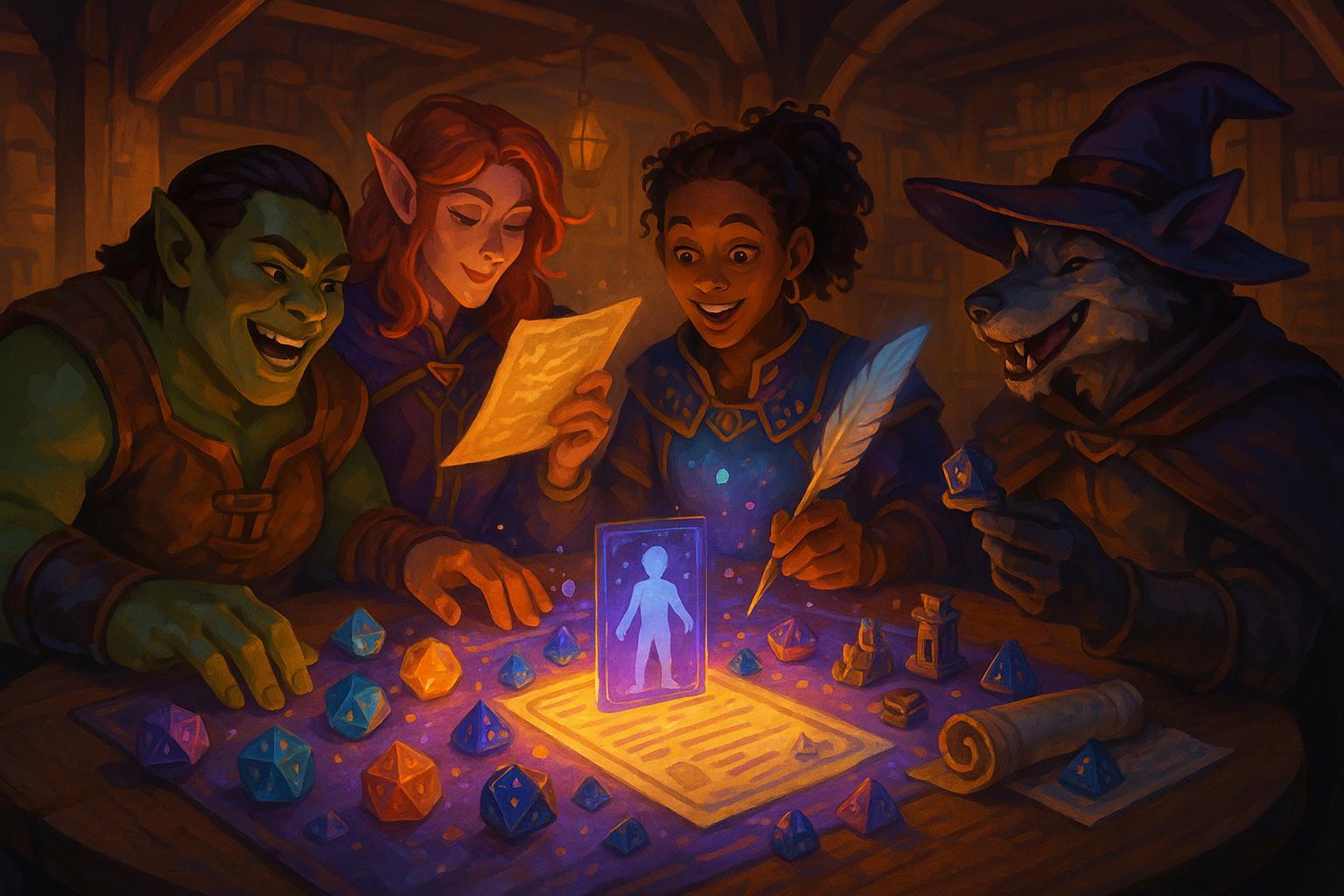Spotlight time in tabletop role-playing games (TTRPGs) is about ensuring every player gets their moment to contribute meaningfully to the story. It’s not just about equal speaking time but creating opportunities for players to feel involved based on their preferences. Here's what you need to know:
- Why It Matters: Balanced spotlight time keeps players engaged, strengthens group dynamics, and prevents frustration or disengagement.
- Common Challenges: Dominant players, quieter participants, online play issues, and differing expectations can disrupt balance.
- How to Manage It: Use techniques like rotating focus, incorporating character backstories, and designing group challenges to share the narrative spotlight effectively.
- Avoid These Mistakes: Over-correcting for balance, ignoring player preferences, or letting one player dominate can harm the group experience.
- Tools to Help: Session planning templates, tick lists, and game systems with built-in balance mechanics can make this easier.
The goal is to create a game where everyone feels included and valued while maintaining the story's natural flow. Read on for strategies and tools to manage spotlight time effectively.
How To Handle Passive Players In D&D (Dungeons and Dragons | GM Tips)
How to Balance Spotlight Time
Balancing spotlight time is all about creating a natural rhythm that ensures everyone at the table feels involved and valued. The goal isn’t to distribute equal speaking time but to provide equal opportunities for meaningful engagement, tailored to each player’s preferences and comfort levels.
"Each player at your table is unique, each has unique spotlight preferences. The key is ensuring that everyone feels fulfilled, even if that spotlight time looks different." - Bryan Cetroni
Rotating Scene Focus
A simple yet effective way to balance the spotlight is by rotating the narrative focus among players. This requires the Game Master to actively monitor participation and ensure no one is left out.
One technique is to track major contributions, like decisions or actions, using a tally system. You can also use the table rotation method: when the group faces a decision or explores a new location, systematically ask each player what their character is doing or thinking. This approach gives quieter players time to prepare their responses while preventing more vocal players from dominating the scene.
If one player starts to take over, gently redirect the focus. For example, you could say, "While Marcus is examining the door, what is everyone else doing?" or "Sarah, how does your character react to what just happened?" These transitions help keep the game balanced. For online sessions, clear verbal cues can make turn-taking smoother.
Another way to shift focus naturally is by weaving character histories into the storyline, creating moments that spotlight different players.
Using Character Backstories
Character backstories are a fantastic tool for creating personalized spotlight moments. By integrating these backstories into the main narrative, you can highlight each character’s unique strengths and make their contributions feel essential.
For example, if one character has noble connections, you could introduce a subplot involving political intrigue. If another character is skilled in wilderness survival, you might design an environmental challenge that requires their expertise. Tying backstory elements into the central plot - like a rogue’s former criminal contact or a cleric’s religious order - adds depth to the story while giving each player a chance to shine.
These moments not only enhance individual engagement but also encourage more collaborative and immersive storytelling.
Group Problem-Solving Activities
Collaborative challenges are another excellent way to balance spotlight time. Design encounters that require teamwork rather than individual heroics. For example, a heist could involve one player disabling security, another creating a diversion, and a third gathering intelligence. This structure ensures everyone has a role to play.
"When splitting the party, you generally want every player to be contributing equally and to have an equal amount of time in the 'spotlight'" - Justin Alexander
If the party splits up, make sure each subgroup gets equal attention. Rotate between groups consistently to keep everyone engaged. For players waiting their turn, involve them in strategy discussions or brainstorming sessions to keep them connected to the action.
You can also use direct, engaging questions to draw quieter players into the story.
"Highlight questions pull players into the narrative organically, letting them shape the story in a way that suits their character." - Bjarke the Bard
Common Mistakes and How to Fix Them
Managing spotlight time in a tabletop game can be tricky. Even the most well-meaning Game Masters (GMs) can unintentionally disrupt the flow of a session by falling into common pitfalls. Let’s look at some of these mistakes and how to address them to create a more balanced and enjoyable experience for everyone at the table.
Over-Correcting for Balance
One common misstep is trying too hard to give every player equal spotlight time. While the intention is good, this can make the game feel stiff and overly calculated. Players naturally have different needs when it comes to attention, and forcing strict equality can disrupt the flow of the story and make things feel unnatural.
For example, interrupting a dramatic scene just to rotate the focus can break immersion and leave players feeling rushed. Instead of enforcing rigid balance in a single session, think long-term. Some sessions might center on one character’s backstory or goals, while others shift the focus to someone else. Over time, this creates a natural balance.
To help involve everyone without forcing individual moments, consider group activities like skill challenges or puzzles. These scenarios allow all players to contribute in a way that feels organic, ensuring no one is left out without disrupting the narrative’s rhythm.
Ignoring Player Preferences
Another mistake is overlooking individual player preferences for how much attention they want. Some players love being in the spotlight, while others are more comfortable observing or contributing in smaller ways. Treating everyone the same can lead to discomfort or disengagement.
For example, shy or introverted players might feel overwhelmed if suddenly thrust into a major scene without preparation. On the other hand, more outgoing players might feel stifled if they’re constantly held back to make room for others. Both situations can hurt the group’s overall enjoyment.
The solution? Talk to your players. During a session zero or regular check-ins, ask about their preferences. Questions like “Do you enjoy jumping into roleplay scenes, or would you prefer a heads-up first?” can provide valuable insight. Once you know their comfort levels, adapt your style. For quieter players, use gentle prompts like, “What’s your character thinking right now?” For those who are more assertive, give them space to shine, but make sure they don’t unintentionally overshadow others.
Letting One Player Take Over
Perhaps the most disruptive mistake is allowing one player to dominate the game. This often happens with enthusiastic or experienced players who feel comfortable taking charge. While their energy can be a great asset, it can also leave quieter players feeling sidelined and undervalued.
When one person consistently takes over, others might disengage entirely, feeling their contributions don’t matter. This can create tension within the group.
To address this, set clear expectations early. Establish turn-taking rules or group decision-making processes that ensure everyone has a voice. If one player starts to dominate, gently redirect the focus: “While Marcus examines the artifact, what are the rest of you doing?” or “Before we move forward, let’s hear everyone’s thoughts on the plan.”
Structured approaches can also help. For example, go around the table to gather input during key decisions or create scenes that require specific characters’ skills. If the issue persists, have a private conversation with the dominant player. Let them know you value their enthusiasm but need their help in making sure everyone gets a chance to contribute.
You can also use tools like a simple tick list to track who has participated in major moments. This helps you spot imbalances early and adjust before they become an issue. The goal isn’t to stifle enthusiastic players but to channel their energy in ways that benefit the whole group.
Tools and Resources for Spotlight Management
Managing spotlight time effectively is much easier when you have the right tools at your disposal. Instead of relying on guesswork, experienced Game Masters (GMs) often turn to session planning templates, tracking systems, and game mechanics designed to encourage balanced play. These resources help you stay organized while ensuring every player gets their moment to shine.
Session Planning Templates
Session planning templates are an essential tool for managing spotlight time. These structured documents allow you to organize campaign details, track player involvement, and plan upcoming sessions with fairness in mind. By keeping clear records, you can avoid second-guessing how spotlight time was distributed in previous games.
GMs sometimes refer to these templates as a "shining moment checklist", designed to ensure every player has a standout scene in each session. One popular choice is the Sly Flourish Campaign Template on Notion, which boasts a 4.95/5 rating from over 100 users.
For GMs who prefer fillable PDFs, platforms like Etsy offer numerous campaign planning bundles. For instance, Wendy Kratz, who runs a high school gaming club, praised the "DnD Campaign Planner Bundle", saying:
"This was easy to use and now my campaign for the High School club I run is organized! All templates are easy to use and work well when writing a Homebrew!"
The trick is finding a template that suits your planning style. Whether you like detailed, session-by-session outlines or broader campaign arcs, templates that include space for session recaps can help you evaluate how well spotlight time was balanced. These tools provide a solid foundation and pair well with game systems that automate balanced play.
Game Systems That Support Balanced Spotlight Time
Beyond planning tools, some tabletop role-playing game (TTRPG) systems are designed with mechanics that naturally balance spotlight time. These systems embed fairness into their core rules, making it easier for GMs to manage player engagement.
Class-based systems are a prime example. Each character class often fills a unique role, creating natural opportunities for players to shine in different situations - be it combat, stealth, or social encounters.
Take Apocalypse World, for instance. This system assigns distinct roles to each character class in its post-apocalyptic setting. The Hardholder manages territory and followers, the Brainer manipulates minds, the Gunlugger handles combat, the Angel provides medical care, the Chopper leads a gang, and the Savvyhead focuses on technology. These roles are so diverse that players naturally rotate into the spotlight as the story unfolds, ensuring everyone gets a chance to contribute meaningfully.
When selecting a game system, look for mechanics that distribute narrative control and spotlight time evenly. Features like rotating GM duties, shared storytelling elements, or built-in rules for character moments can significantly reduce your workload while enhancing player satisfaction.
For a deeper dive into various TTRPG systems, check out the TTRPG Games Directory (https://ttrpg-games.com). It offers detailed descriptions of game mechanics and insights into how they encourage player interaction. Choosing the right system for your group can make spotlight management feel effortless.
sbb-itb-b8b00a5
Customizing Spotlight Time for Your Group
Every group has its own rhythm and personality. Understanding how your group interacts helps you adjust spotlight management techniques to fit their unique dynamics. By doing so, you can ensure everyone feels included and engaged.
"The players at my table are really good at sharing spotlight time but every now and then things tend to linger a little too long on one character or another character sort of fades into the background. It's incumbent on me to recognize when this is happening and do something about it."
Whether you're managing mixed experience levels, welcoming new players, or adapting to different group sizes, tailoring your approach can turn potential challenges into opportunities for richer gameplay.
Mixed Experience Levels
Groups with players of varying experience levels often face unique challenges. Veteran players might naturally take the lead, while newer players may hesitate, unsure of how to contribute.
To address this, give everyone structured opportunities to shine. For example, you could go around the table to ensure each player has a chance to act. This prevents any one person from dominating and gives everyone a predictable moment to participate.
Skill challenges are another great tool. By designing scenarios that require a mix of skills - like physical actions, social interactions, or creative problem-solving - you create opportunities for everyone, regardless of experience, to contribute meaningfully.
Regular check-ins with your players are also important. Newer players, in particular, may not feel comfortable speaking up about being sidelined. By asking for feedback, you can fine-tune how you distribute the spotlight to create a more inclusive experience.
Adding New Players
Bringing new players into an established group can be tricky. Without careful attention, newcomers might feel overshadowed by the existing dynamic.
Start by weaving the new character into the story. Clear connections to the narrative give them natural entry points for interaction without forcing it. In the early sessions, keep a close eye on how spotlight time is shared to help the new player find their footing.
Encourage seasoned players to include the newcomer by exploring their character's backstory or teaming up during encounters. This fosters collaboration and helps the new player feel welcome. A simple tracking system, like a tick list, can also help you ensure everyone gets equitable participation as you gauge the new player's comfort level and style.
Different Group Sizes and Playstyles
Spotlight management looks different depending on your group size and playstyle. Smaller groups often share the spotlight more naturally, while larger groups may require a more deliberate approach.
In bigger groups, players often get less individual screen time. To address this, use quick but meaningful interactions and rotate focus so that everyone knows when it's their turn to shine.
For combat-heavy games, consider tweaking encounter difficulty or adding multi-objective challenges to ensure everyone has a role. Roleplay-focused sessions, on the other hand, can sometimes lead to one player dominating social scenes. To balance this, design moments that encourage multiple perspectives or directly invite quieter players to contribute. Pay attention to who consistently takes center stage and who might be fading into the background.
"For the spotlight to be truly effective in your campaign you need players that will embrace the opportunity to celebrate a character other than their own. You need to foster and encourage a gaming environment where your players are invested in each others' characters."
Key Takeaways for Managing Spotlight Time
Handling spotlight time effectively in TTRPG (tabletop role-playing game) sessions can make all the difference between a good game and an unforgettable one. When every player feels seen and valued, the experience becomes richer for everyone involved.
One way to ensure no one gets overlooked is by actively tracking participation. Using tools like tick lists can help you keep tabs on who's had their moment in the spotlight. This simple method prevents the all-too-common issue of one player dominating the session while others fade into the background.
Striking the right balance requires a mix of preparation and adaptability. While having a plan ensures everyone gets a chance to shine, being flexible allows for those organic moments when a character naturally takes center stage. The trick is knowing when to guide the spotlight and when to let it flow on its own.
Encounters that rotate focus or encourage group problem-solving are great for creating opportunities for everyone to contribute. Skill challenges, for instance, are a fantastic way to involve the whole group because they require input from multiple players. As you design these moments, think about how each character's unique abilities can play a role in the solution.
Understanding your players' individual preferences is equally important. Some players love being in the spotlight, while others are more comfortable observing. By tailoring engagement opportunities to fit these preferences, you can maintain a comfortable and inclusive environment for everyone.
Regular communication with your players is another key element. Check in with them to fine-tune your approach and address any concerns before they escalate. Since players might not always notice if they're participating too much or too little, it’s up to you, as the game master, to maintain that balance.
By combining these strategies with the right game system, you can create sessions that are not only balanced but also deeply engaging.
Finding the Right Games with TTRPG Games Directory

Once you’ve mastered the art of managing spotlight time, the next step is choosing a game system that supports balanced play. The TTRPG Games Directory is a valuable resource for this. It provides detailed descriptions of various tabletop RPGs, including their mechanics and playstyles, so you can find games that naturally encourage equitable participation.
Some systems are designed with built-in mechanics that make spotlight sharing easier. Features like structured turn-taking or collaborative storytelling can help ensure everyone has a chance to contribute. By exploring the directory, you can identify systems that align with your group’s style and preferences.
Whether your group enjoys tactical combat, immersive storytelling, or character-driven narratives, the directory offers a wide range of options to suit your needs. It’s especially helpful when introducing new players or adapting to changing group dynamics, allowing you to discover games that fit your evolving playstyle.
When you combine thoughtful spotlight management with a game system that complements your group’s dynamic, you set the stage for truly inclusive and engaging TTRPG sessions. This approach ensures players stay invested and excited to come back for more adventures.
FAQs
How can I handle dominant players in a TTRPG without disrupting the game?
Managing a dominant player in a tabletop RPG can be tricky, but it’s crucial to make sure everyone at the table feels involved and has fun. The first step? Have a private, friendly conversation with the player. Focus on the positive - explain how sharing the spotlight can make the game more enjoyable for the entire group.
During sessions, establish clear rules for turn-taking and actively encourage quieter players to contribute their ideas. You might also design moments in the game that naturally give each character their chance to shine, ensuring everyone has a moment in the spotlight. By keeping communication open and encouraging a team-oriented atmosphere, you can keep the game running smoothly while making sure everyone feels included.
How can I help quieter players feel more involved during online TTRPG sessions?
Creating a space where quieter players feel comfortable in online TTRPG sessions starts with fostering a relaxed and welcoming environment. The goal is to encourage their involvement without overwhelming them. One way to do this is by tailoring opportunities that suit their comfort zone - like giving their characters moments to shine in ways that match their personality or preferred playstyle.
As the game master, you have the ability to steer the session so everyone gets a moment in the spotlight. For quieter players, this might mean asking thoughtful questions about their character’s actions or feelings, or presenting scenarios where stepping into a leadership role feels natural. The key is to avoid putting them on the spot. Instead, use subtle prompts to gently pull them into the story. These small adjustments can make a big difference, creating a space where every player feels valued and engaged.
How can I use character backstories to keep players engaged and ensure everyone gets spotlight time?
Integrating Character Backstories into Your Campaign
Tying character backstories into your campaign is a fantastic way to keep players engaged while ensuring everyone gets their moment to shine. By incorporating elements like NPCs, specific locations, or personal quests from their backstories into the main storyline, you make each character feel like a vital part of the narrative. This approach not only strengthens their connection to the game but also naturally creates opportunities for individual spotlight moments.
To keep things balanced, try to focus on different aspects of each character’s background as the campaign unfolds. For instance, you could design scenes that align with their personal goals, showcase their unique abilities, or resolve lingering story arcs. Encouraging players to craft backstories that connect to the campaign’s themes or include shared secrets can also promote teamwork and collaborative storytelling, ensuring everyone feels both involved and appreciated.


